Related Research Articles

A reconnaissance satellite or intelligence satellite is an Earth observation satellite or communications satellite deployed for military or intelligence applications.

The CORONA program was a series of American strategic reconnaissance satellites produced and operated by the Central Intelligence Agency (CIA) Directorate of Science & Technology with substantial assistance from the U.S. Air Force. The CORONA satellites were used for photographic surveillance of the Soviet Union (USSR), China, and other areas beginning in June 1959 and ending in May 1972.

The National Reconnaissance Office (NRO) is a member of the United States Intelligence Community and an agency of the United States Department of Defense which designs, builds, launches, and operates the reconnaissance satellites of the U.S. federal government, and provides satellite intelligence to several government agencies, particularly signals intelligence (SIGINT) to the NSA, imagery intelligence (IMINT) to the NGA, and measurement and signature intelligence (MASINT) to the DIA.

STS-36 was a NASA Space Shuttle mission, during which Space Shuttle Atlantis carried a classified payload for the U.S. Department of Defense into orbit. STS-36 was the 34th shuttle mission overall, the sixth flight for Atlantis, and the fourth night launch of the shuttle program. It launched from Kennedy Space Center, Florida, on 28 February 1990, and landed on 4 March.

The Manned Orbiting Laboratory (MOL) was part of the United States Air Force (USAF) human spaceflight program in the 1960s. The project was developed from early USAF concepts of crewed space stations as reconnaissance satellites, and was a successor to the canceled Boeing X-20 Dyna-Soar military reconnaissance space plane. Plans for the MOL evolved into a single-use laboratory, for which crews would be launched on 30-day missions, and return to Earth using a Gemini B spacecraft derived from NASA's Gemini spacecraft and launched with the laboratory.
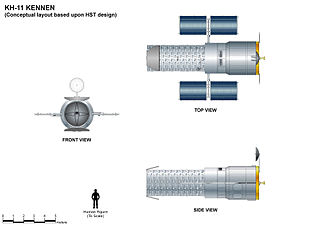
The KH-11 KENNEN is a type of reconnaissance satellite first launched by the American National Reconnaissance Office in December 1976. Manufactured by Lockheed in Sunnyvale, California, the KH-11 was the first American spy satellite to use electro-optical digital imaging, and so offer real-time optical observations.
Enhanced Imaging System (EIS), officially referred to as "Enhanced Imagery System", previously known as 8X, and sometimes unofficially known as Misty 2 and KH-13, is an American reconnaissance satellite program. A derivative of the Improved Crystal satellites, EIS replaced Misty, and was intended to provide more coverage and dwell time than previous reconnaissance satellites; like Misty, it has stealth capabilities. Only one EIS satellite has been launched; USA-144, which was placed into orbit by a Titan IVB rocket on 22 May 1999.

Lacrosse or Onyx is a series of terrestrial radar imaging reconnaissance satellites operated by the United States National Reconnaissance Office (NRO). While not officially confirmed by the NRO or the Government of the United States prior to 2008, there was widespread evidence pointing to its existence, including one NASA website. In July 2008, the NRO itself declassified the existence of its synthetic aperture radar (SAR) satellite constellation.
Zirconic is the name of a program for the development of stealth reconnaissance satellites for the National Reconnaissance Office (NRO). The program includes the Misty and Prowler spacecraft.
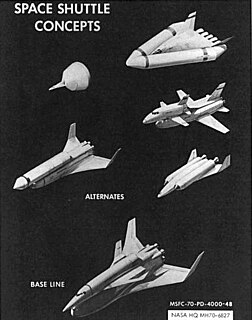
Before the Apollo 11 Moon landing in 1969, NASA began studies of Space Shuttle designs as early as October 1968. The early studies were denoted "Phase A", and in June 1970, "Phase B", which were more detailed and specific. The primary intended use of the Space Shuttle was supporting the future space station, ferrying a minimum crew of four and about 20,000 pounds (9,100 kg) of cargo, and able to be rapidly turned around for future flights.

Space Launch Complex 6 at Vandenberg Space Force Base in California is a launch pad and support area. The site was originally developed for Titan III rockets and the Manned Orbiting Laboratory, but these were cancelled before construction of SLC-6 was complete. The complex was later rebuilt to serve as the west coast launch site for the Space Shuttle, but went unused due to budget, safety and political considerations. The pad was subsequently used for several Athena rocket launches before being modified to support the Delta IV launch vehicle family, which have used the pad since 2006.

POPPY is the code name given to a series of U.S. intelligence satellites operated by the National Reconnaissance Office. The POPPY satellites recorded ELINT data, targeting radar installations in the Soviet Union and Soviet naval ships at sea.
Magnum was a class of SIGINT spy satellites reportedly operated by the National Reconnaissance Office (NRO) for the United States Central Intelligence Agency (CIA). The program remains classified, and the information that exists is speculative.
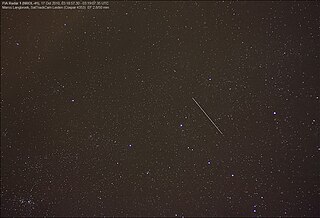
Future Imagery Architecture (FIA) was a program awarded to Boeing to design a new generation of optical and radar imaging US reconnaissance satellites for the National Reconnaissance Office (NRO). In 2005 NRO director Donald Kerr recommended the project's termination, and the optical component of the program was finally cancelled in September 2005 by Director of National Intelligence John Negroponte. FIA has been called by The New York Times "perhaps the most spectacular and expensive failure in the 50-year history of American spy satellite projects." Despite the optical component's cancellation, the radar component, known as Topaz, has continued, with four satellites in orbit as of February 2016.

Jeffrey K. Harris is an American aerospace executive who served as 11th director of the National Reconnaissance Office from 1994 to 1996. He is currently the chairman of the board of the United States Geospatial Intelligence Foundation.
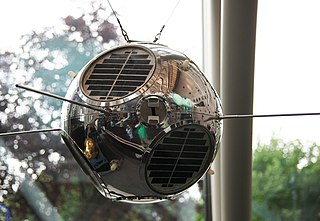
SOLRAD 4B was a solar X-ray, ultraviolet, and electronic surveillance satellite. Developed by the United States Navy's United States Naval Research Laboratory, it was the fifth in both the SOLRAD and the GRAB programs.
USA-223, known before launch as NRO Launch 32, is an American reconnaissance satellite which was launched in 2010. It is operated by the United States National Reconnaissance Office. It presently holds the record for being the largest spy satellite ever launched.

USA-224, also known as NROL-49, is an American reconnaissance satellite. Launched in 2011 to replace the decade-old USA-161 satellite, it is the fifteenth KH-11 optical imaging satellite to reach orbit.
Prowler was an American reconnaissance satellite launched aboard Space ShuttleAtlantis in 1990 in order to study Soviet satellites in geosynchronous orbit. The government of the United States has never acknowledged its existence, however it has been identified by amateur observers and through leaked information.
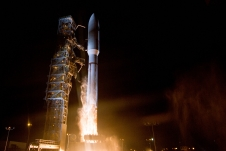
USA-247, also known as NRO Launch 39 or NROL-39, is an American reconnaissance satellite, operated by the National Reconnaissance Office. The USA-247 launch received a relatively high level of press coverage due to the mission's choice of logo, which depicts an octopus sitting astride the globe with the motto "Nothing Is Beyond Our Reach". The logo was extensively criticized in light of the 2013 surveillance disclosures.
References
- 1 2 Keefe, Patrick Radden (February 2006). "I Spy". Wired. Retrieved 27 December 2010.
- ↑ 1990-019B
 This article incorporates text from this source, which is in the public domain.
This article incorporates text from this source, which is in the public domain. - ↑ 1999-028A
 This article incorporates text from this source, which is in the public domain.
This article incorporates text from this source, which is in the public domain. - ↑ Priest, Dana (11 December 2004). "New Spy Satellite Debated On Hill: Some Question Price and Need". The Washington Post. Retrieved 27 December 2010.
- ↑ "NRO Payload Guesses".
- ↑ Jonathan's Space Report: List of satellite launches
- ↑ Clifford, Neil (25 August 1995). "AFP-731/1990-019B/NORAD-20516". satobs.org. Retrieved 8 December 2018.
- ↑ ""Misty" Stealth Spy Satellite Program Cancelled?". SatNews. 26 June 2007. Retrieved 28 December 2010.[ permanent dead link ]